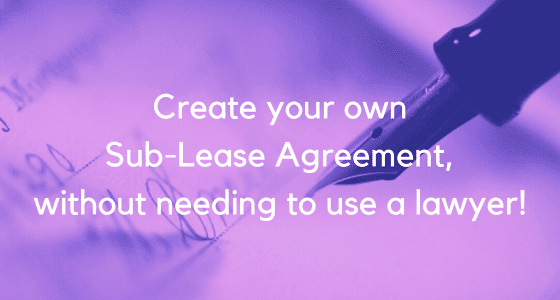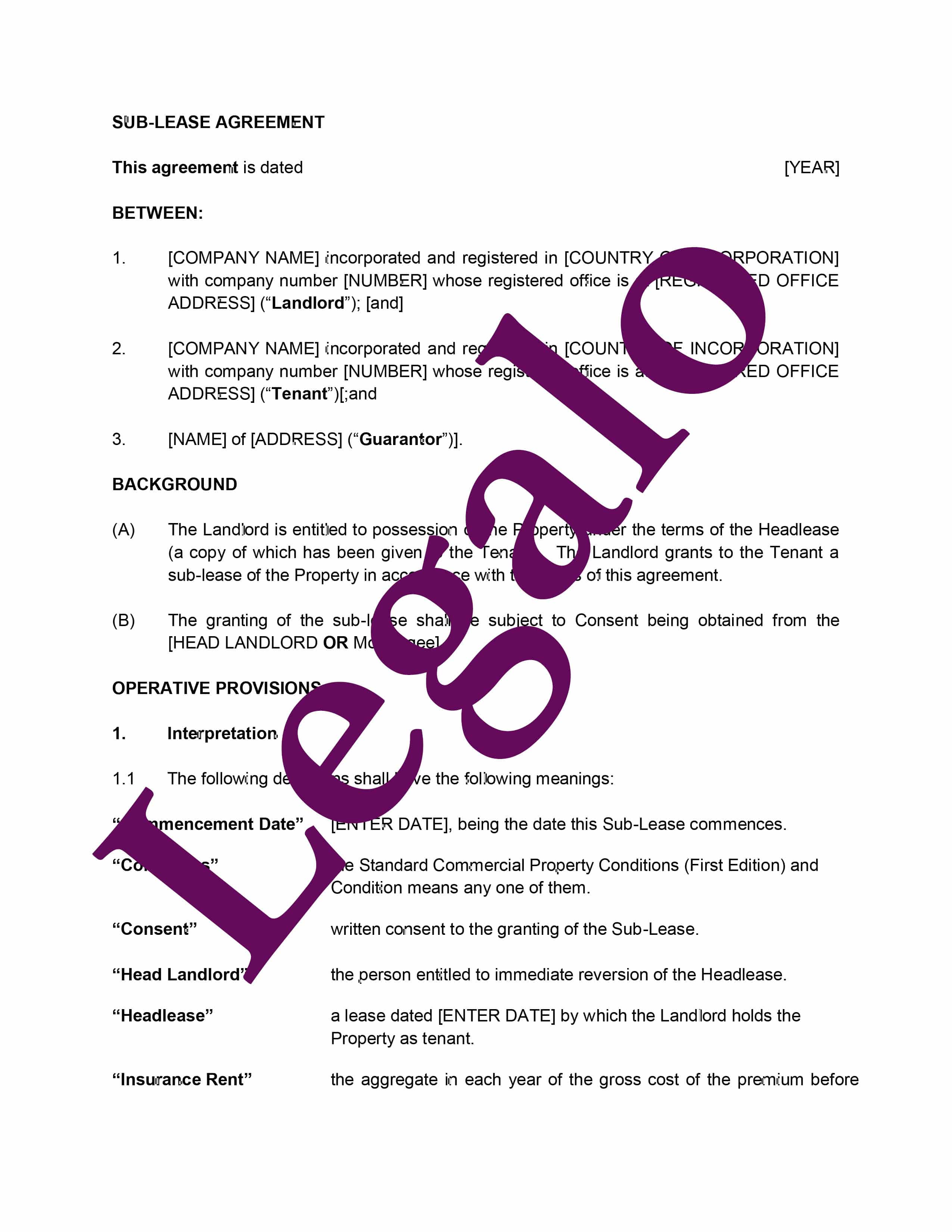Sub-Lease Agreement
Our Sub-Lease Agreement template:
- UK expert-drafted template
- Easy to edit with full guidance notes
- Value for money
- Robust legal protection

How Does It Work?
-
1. Download
-
2. Edit
-
3. Print
-
4. Sign
Our Sub-Lease Agreement template is for use by a landlord (which is itself a tenant of a lease of business property, i.e. the headlease) when sub-letting the whole of the commercial unit to a tenant.
We have not drafted this sub-lease to be suitable for sub-letting only part of your unit, as that is a more complex matter in legal terms. You could however try a licence to occupy for that if it is to be on a short-term basis.
When to use our Sub-Lease Agreement template
You can customise it to suit your individual needs. It has optional clauses, so it will work whether there is or is not:
1. a guarantor of the lease; or
2. a right to renew this sub-lease when it expires (i.e. “security of tenure”).
This type of Sub-lease Agreement puts in place a robust and detailed agreement that is suitable for both short-term and long-term sub-letting of commercial property. You can use it for property in England and Wales, but not Scotland.
David, one of our founders and a UK solicitor of over twenty years, has drafted the template. This ensures that you can rely on the document being up-to-date and legally comprehensive. Our detailed guidance notes:
- come free with the template;
- offer a clause-by-clause explanation of the agreement; and
- make completing the final document simple and fast.
A copy of the guidance notes are available here: guide to this sub-lease agreement template.
Accompanying our document you will also receive a free copy of the prescribed form of words for contracting out of the right for the tenant to apply for a new lease on expiry under the Landlord & Tenant Act 1954 (the “security of tenure” provisions). These are also available for free separately from our website – just click the above link. The guide to this template also explains about the security of tenure provisions.
Using our Sub-Lease Agreement template
You can download this template for a Sub-lease Agreement in Word format at the click of a button once purchased. You can then easily edit it to suit your own needs.
We provide a full money-back guarantee if you are not happy with your template document for any reason.
Once bought, the template can be reused as many times as you want for creating further sub-leases at no further cost. We keep our templates under review to ensure they are up to date. Whenever we update a template that you have bought, we will notify you by email and you will get a free updated document.
How and when to use our Sub-Lease Agreement template
This agreement is sometimes also known as a sub-letting, underlease or underletting agreement. If you are a tenant under a lease of commercial property, you might find yourself no longer needing to use that space at some point. In this situation, if you can find a tenant willing to take it, you will need a sub-lease agreement. They would then be the “sub-tenant”. The sub-letting agreement would set out the rights and responsibilities that the sub-tenant has to adhere to. The majority would most likely be ones that are in the main lease. This means that the sub-tenant would:
- become responsible for the relevant part of the monthly rent, and
- also be bound by the other obligations that are in the main lease.
Our sub-lease agreement explains the terms of the new sub-letting. These are in easy to understand terms, so that you can fill it out quickly.
You will most likely need to get the permission of the landlord to sub-let – you should check the terms of the main lease to see if this is the case. If so, you will also need a licence to sub-let. This is the document under which the landlord formally gives his permission for the sub-letting. Legalo have a licence to sub-let template available for you.
Your responsibilities as original tenant
Even when you have a sub-lease agreement, as the original tenant, you are still responsible to the landlord for complying in full with the terms of the main lease with your landlord. If the new sub-tenant is unable to meet their responsibilities under the sub-lease, it will still fall to you as the original tenant to fulfil them. For example, maintaining the property as well as payment of the monthly rent. When you have to take over the rights and responsibilities because the sub tenant failed to meet them, you will have a claim against the sub-tenant for breach of the sub-lease agreement.
If you need the full batch of documents for the sub-letting of a lease, we offer 25% off when you buy them all at the same time using our discount package – click here for more details.
If you would like to see our other commercial property documents, click on the link.
FAQs on Sub-Lease Agreements
Below we have answered the top questions on this subject from the Internet.
What is a sub-lease agreement?
A sub-lease agreement in the UK is a legal contract between a tenant (the sub-tenant) and an existing tenant (the head-tenant) in the context of a sub-let arrangement. It allows the sub-tenant to rent all or part of the property from the head-tenant, while the head-tenant retains responsibility to the landlord for their own original lease. This only works if the head lease allows sub-lease agreements, which is usually only permitted with the landlord’s consent. A sub-lease agreement grants the sub-tenant certain rights and responsibilities, such as paying rent and abiding by lease terms. The head-tenant retains ultimate responsibility to the landlord for ensuring rent is paid and compliance with the other terms of the head lease.
How do I make a sub-letting agreement?
A sub-letting agreement needs to include:
- If needed, evidence of landlord consent, such as a signature. This is usually on a document called a licence to sub-let.
- The rent amount, duration, duties and responsibilities.
- Necessary clauses regarding compliance with the head lease, payment for services and utilities, and maintenance responsibilities.
- Signatures from both tenants.
It must comply with the terms of the head lease. By using Legalo’s sub-lease agreement template, you’ll have a great head-start in drafting your own document, safe in the knowledge that all the necessary points will be included.
What are the rights of a sub-tenant in the UK?
In the UK, a sub-tenant has the right to occupy and use the leased property as specified in the sub-lease agreement. They are entitled to the quiet enjoyment of the property and protection against eviction without due legal process, just as applies to any other tenant. Sub-tenants may also have certain rights under the head lease, such as those related to repairs and maintenance, but their rights are ultimately subject to the terms of the sub-lease and the head lease. This is why it is essential for sub-tenants to understand and adhere to the terms and conditions outlined in both of these agreements to protect their rights.
However, note that often a clause in the sub-lease agreement is that if the head lease terminates, then the sub-lease will too.
What is the difference between sub-let and sub-lease?
These are talking about exactly the same thing in legal terms, but “to sub-let” is the verb and “the sub-lease” is the noun in grammatical terms, as in the sub-lease agreement.
Who gets in trouble for sub-letting?
If unauthorised sub-letting was occurring in a premises, various parties can face consequences:
- Head Tenant: If sub-letting without landlord consent, the head tenant may face eviction, lease termination, or legal action. They may also get into trouble if the sub-tenant causes any damages to the property or breaches any terms in the head lease agreement.
- Sub-tenant: If the sub-tenant is aware of the unauthorised sub-letting, they might be asked to vacate, and any rent paid could be at risk.
- Landlord: The landlord may take legal action against the head tenant for violating the lease terms, terminate the head lease and, as a result, be able to evict the sub-tenant.
What are the risks of illegal sub-letting?
Sub-letting in breach of the terms of the head lease carries several risks:
- Eviction: The head tenant may face eviction for violating the lease agreement.
- Legal Action: The landlord can take legal action against the head tenant, leading to damages.
- Loss of Control: The landlord loses control over who resides in their property until it takes enforcement action for the breach.
- Financial Consequences: The head tenant remains liable for rent and damages caused by the sub-tenant.
- Damage to Credit: Legal disputes can damage the head tenant’s credit history.
- Termination of the Sub-Lease Agreement: if the head lease is terminated, its terms may specify that any unauthorised sub-lease agreement is also terminated at the same time.
How do I report someone who is sub-letting?
This is only relevant if the sub-letting is not in compliance with the head lease. The casual observer is unlikely to know if this is the case. So it is a private matter between the landlord and tenant. However if you ask the landlord and they confirm there should not be sub-letting, then you might assist the landlord in this way.
- Contact the Landlord: Inform the property owner or management company in writing about your suspicions, being sure to attach evidence.
- Consult the Lease: The landlord will need to check the lease for specific clauses on banning sub-letting without its consent, to ensure that the sub-letting is illegal.
- Gather Evidence: Document any information or evidence of the sub-letting arrangement, such as communications or observations. This will strengthen your case and aid the landlord to carry out an investigation and take necessary enforcement action.
Is sub-letting a criminal offence?
This is a “civil” matter in the UK: one of possible breach of contract between the landlord and tenant. It is not a criminal matter, so no criminal offence is committed in the UK by sub-letting. In more detail:
- Sub-letting without proper authorisation is not a criminal offence in the UK;
- It may constitute a breach of the lease agreement; and
- As such, it may lead to civil consequences, such as eviction and the tenant having to pay damages.
Is sub-letting illegal in the UK? Can a sub-lease be legal?
Illegality generally means a breach of the law (i.e. a criminal offence), not a breach of a contract. Sub-letting is not “illegal” in this sense. However, it often requires the landlord’s consent so that it is not a breach of contract. Most standard leases permit sub-letting with the landlord’s approval. When the head lease explicitly bans sub-letting without permission, such sub-letting without permission:
- will breach the lease’s terms; and
- potentially lead to eviction and other legal consequences.
It’s crucial to check the head lease and seek the landlord’s agreement in writing when needed.
Is it illegal to sub-let a council property?
In terms of residential properties, sub-letting a council property in the UK without proper authorisation is:
- generally a breach of the tenancy agreement;
- but not a criminal offence, so not “illegal”.
Social housing is allocated to specific individuals or families based on housing needs and eligibility criteria. This means that sub-letting without permission will likely breach the tenancy agreement, potentially leading to eviction and other legal consequences. Councils are highly unlikely to permit sub-letting.
What is the difference between a lodger and a sub-let?
In terms of residential property, a lodger is a person who rents a room within a property where the owner lives. The lodger usually has less autonomy and is more dependent on the owner. In contrast, a sub-let involves a tenant renting their entire property or part of it to another party under a sub-lease agreement. Sub-letting provides the sub-tenant with more independence and control over the space. This is because they usually have exclusive use of the area they rent during the sub-lease period.




